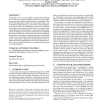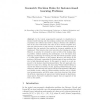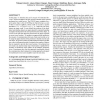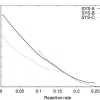125
Voted
GIS
2010
ACM
14 years 11 months ago
2010
ACM
In this paper we focus on the problem of continuously monitoring the set of Reverse k-Nearest Neighbors (RkNNs) of a query object in a moving object database using a client server...
CSDA
2007
15 years 10 days ago
2007
In this paper, we propose a novel non-parametric clustering method based on non-parametric local shrinking. Each data point is transformed in such a way that it moves a specific ...
119
Voted
VLDB
1997
ACM
15 years 3 months ago
1997
ACM
A new access method, called M-tree, is proposed to organize and search large data sets from a generic "metric space", i.e. where object proximity is only defined by a di...
112
click to vote
BTW
2007
Springer
15 years 4 months ago
2007
Springer
: The reverse k-nearest neighbor (RkNN) problem, i.e. finding all objects in a data set the k-nearest neighbors of which include a specified query object, has received increasing a...
152
Voted
ADBIS
2007
Springer
15 years 4 months ago
2007
Springer
Classification based on k-nearest neighbors (kNN classification) is one of the most widely used classification methods. The number k of nearest neighbors used for achieving a high ...
117
click to vote
PREMI
2005
Springer
15 years 5 months ago
2005
Springer
In the typical nonparametric approach to classification in instance-based learning and data mining, random data (the training set of patterns) are collected and used to design a d...
114
click to vote
GIS
2009
ACM
15 years 7 months ago
2009
ACM
In this paper, we formalize the novel concept of Constrained Reverse k-Nearest Neighbor (CRkNN) search on mobile objects (clients) performed at a central server. The CRkNN query c...
107
Voted
ICPR
2002
IEEE
16 years 1 months ago
2002
IEEE
In Handwritten Character Recognition, the rejection of extraneous patterns, like image noise, strokes or corrections, can improve significantly the practical usefulness of a syste...
ICIP
2008
IEEE
16 years 2 months ago
2008
IEEE
An empirical study of the domain of patch-based learning algorithms for image and video processing is conducted. As patch-based algorithms are commonly used, knowledge of the prop...




